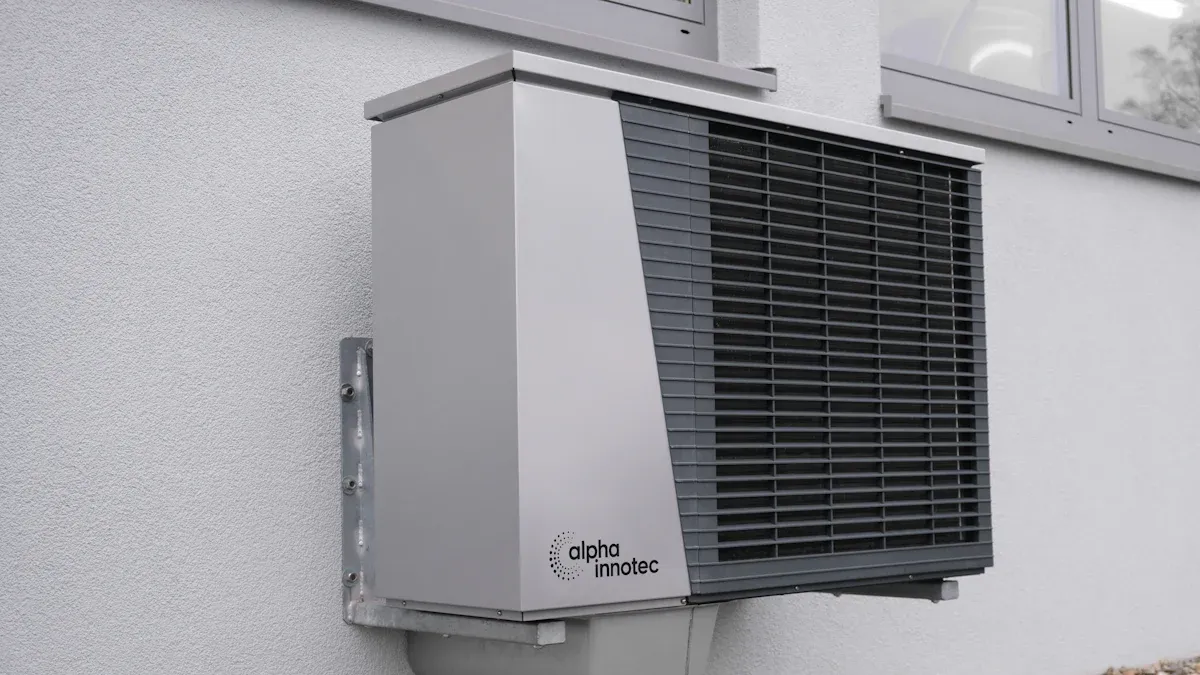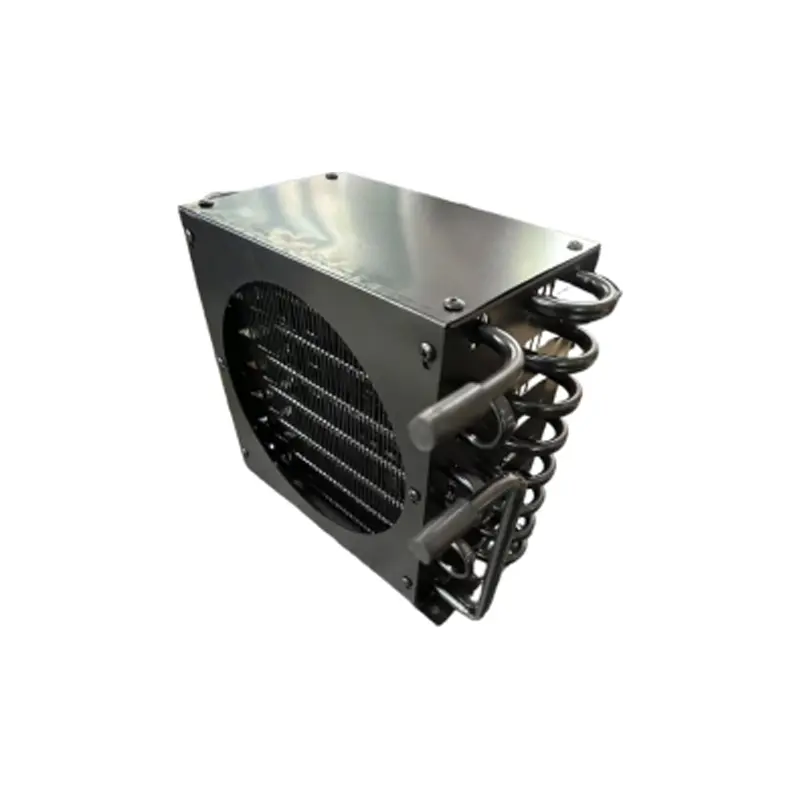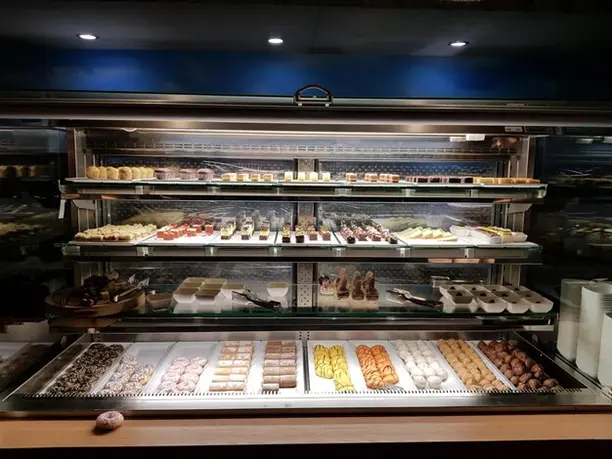7 Safety Steps for Installing Commercial Condensers

Installing commercial condensers demands a strong focus on safety. I’ve seen firsthand how improper practices can lead to accidents, equipment damage, or even violations of safety standards. For example, disconnecting power before installation prevents electrical shocks, while using the correct tools reduces injury risks. Establishing safe work practices ensures the well-being of everyone involved. When working with a Wire Tube Condenser, following a detailed checklist minimizes errors and ensures compliance with protocols.
Key Takeaways
- Always check the site carefully before starting. Look for dangers and make sure air can flow well for a safe workspace.
- Use the correct tools and wear proper safety gear (PPE). This lowers risks and keeps you safer while working.
- Keep the work area safe by blocking access and marking danger spots. A tidy and neat workspace helps avoid accidents and saves time.
Step 1: Conduct a Pre-Installation Site Assessment
Inspect the area for hazards and obstructions
Before starting any installation, I always inspect the site thoroughly. Identifying hazards like uneven surfaces, loose debris, or overhead obstructions ensures a safer workspace. I rely on tools like the SafetyCulture inspection app to streamline this process. It allows me to convert paper forms into digital templates, record observations, and even capture annotated photos for documentation. This approach not only saves time but also ensures I don’t miss critical details.
Ensure proper airflow and ventilation
Proper airflow is essential for the efficient operation of a Wire Tube Condenser. I make it a point to check that the installation site has no obstructions blocking air circulation. For example, walls or other equipment placed too close to the condenser can restrict airflow, leading to overheating. I also verify that the ventilation system meets the manufacturer’s specifications. This step prevents performance issues and extends the lifespan of the equipment.
Verify compliance with local building and safety codes
Compliance with local codes is non-negotiable. I always review the relevant building and safety regulations before proceeding. Resources like OSHA Job Hazard Analysis Training provide valuable insights into hazard detection and corrective measures. Following these guidelines ensures that the installation meets legal standards and avoids potential penalties. Additionally, I double-check that the site’s electrical and structural setup aligns with the requirements for a Wire Tube Condenser.
Tip: Always turn off the power supply to the HVAC system before beginning any work. This simple step can prevent serious electrical accidents.
Step 2: Use the Right Tools and Equipment
Check tools for proper working condition
Before starting any installation, I always inspect my tools to ensure they are in excellent working condition. Faulty or poorly maintained tools can lead to accidents or damage to the equipment. For example, I verify that electrical tools are insulated and free from wear or damage. I also confirm that specialized tools, such as coil straighteners or line tracing devices, are functioning correctly. This practice not only ensures safety but also improves efficiency during the installation process.
| Task | Importance |
|---|---|
| Inspect coil, straighten fins, and clean | Ensures efficient heat exchange and prevents failure |
| Check the drain and pan; flush and treat | Prevents water damage and mold growth |
| Verify all electrical connections are tight | Ensures safety and proper operation |
| Document maintenance activities | Provides a record for compliance and future use |
Wear appropriate personal protective equipment (PPE)
Safety always comes first when working with electrical tools or heavy components. I make it a point to wear the right PPE, including insulated gloves, safety glasses, and protective clothing. These items shield me from potential hazards like electrical shocks or flying debris. For instance, when handling refrigerants during a Wire Tube Condenser installation, I ensure my gloves and goggles meet industry standards. Following these precautions minimizes risks and keeps the work environment safe.
- Prioritize safety when using line tracing and wire location tools.
- De-energize circuits or use non-contact methods to reduce electrical accident risks.
- Wear appropriate PPE to protect against electrical hazards.
Follow manufacturer guidelines for wire tube condensers
Adhering to the manufacturer’s guidelines is critical for a successful installation. I always review the manual to understand the specific requirements for the Wire Tube Condenser. This includes verifying that the HVAC system matches the project specifications and ensuring all connections meet safety standards. Proper handling of refrigerants and compliance with safety protocols are also essential. By following these steps, I can guarantee optimal performance and longevity of the equipment.
Tip: Always label equipment properly and establish shock protection boundaries to enhance safety during installation.
Step 3: Secure the Work Area

Restrict unauthorized access with barriers
I always prioritize restricting access to the work area during installation. Unauthorized personnel can disrupt the process or expose themselves to potential hazards. To prevent this, I set up physical barriers like cones, caution tape, or temporary fencing around the site. These barriers serve as a clear visual warning and help maintain a safe environment. For larger projects, I also use signage to communicate specific risks, such as "High Voltage" or "Heavy Equipment in Use." This proactive approach minimizes interruptions and ensures only trained personnel are present.
Clearly mark hazardous zones
Marking hazardous zones is another critical step I never overlook. Areas with electrical components, refrigerant handling, or heavy equipment require clear identification. I use brightly colored tape or paint to outline these zones, making them easily visible. For example, when working with wire tube condensers, I mark the areas where refrigerant lines are being connected. This practice not only protects workers but also prevents accidental damage to sensitive components. Clear markings create a safer workspace and reduce the likelihood of errors.
Maintain a clean and organized workspace
A clean and organized workspace is essential for safety and efficiency. I ensure all tools and materials are stored properly and within easy reach. This reduces the time spent searching for items and minimizes the risk of tripping or other accidents. For instance:
- Essential tools remain at hand, streamlining workflows.
- A clutter-free environment enhances visibility and accessibility.
- Regular trash removal prevents overflow and keeps the area tidy.
Additionally, I follow a simple routine:
- Keep aisles and emergency exits clear.
- Empty trash bins regularly.
- Address untidy areas promptly to prevent escalation.
These practices create a safer, more efficient workspace, reducing the risk of installation mishaps.
Step 4: Follow Electrical Safety Protocols
Turn off the power supply before starting
Safety begins with turning off the power supply. I always ensure this step is completed before starting any electrical work. Working with live electrical parts poses significant risks. For instance:
- Nearly 48% of reported fatalities occur while working near live electrical components.
- Turning off the power supply eliminates this danger and creates a safer environment.
I also double-check that the power is completely off by using a voltage tester. This precaution ensures no residual electricity remains in the system. Skipping this step can lead to severe accidents, so I never compromise on it.
Use insulated tools for electrical work
Using insulated tools is another critical safety measure. These tools are designed to prevent electrical shocks by providing a protective barrier between me and the electrical current. For example:
- Insulated tools reduce the risk of electrical hazards in the workplace.
- Properly insulated wires and tools ensure safe handling of electrical components.
When installing wire tube condensers, I always inspect my tools to confirm they meet safety standards. This practice not only protects me but also ensures the installation process runs smoothly.
Test circuits to ensure no live wires are present
Before proceeding with any installation, I test all circuits to confirm no live wires are present. This step is essential for preventing electrical accidents. I rely on tools like absence of voltage testers (AVTs), which provide accurate and safe results. According to safety standards:
| Standard | Key Points |
|---|---|
| NFPA 70E (2015) | Recommends using rated instruments for direct testing of phase conductors. |
| NFPA 70E (2021) | Introduces AVTs for safer verification without opening equipment. |
| CSA Z462 | Accepts various instruments for verifying absence of voltage. |
AVTs also perform continuity checks and indicate safety with a green light. This ensures I can proceed confidently, knowing the area is safe for work.
Step 5: Handle Heavy Components Safely

Use proper lifting techniques or equipment
Handling heavy components requires careful attention to technique. I always use proper lifting methods to avoid injuries. For example, I bend my knees, keep my back straight, and lift with my legs instead of my back. When the weight exceeds safe limits, I rely on equipment like hoists, dollies, or forklifts. These tools reduce strain and ensure safe handling. Using the right equipment not only protects me but also prevents damage to the condenser components.
Tip: Always inspect lifting equipment before use to ensure it is in good working condition.
Work in teams for large or heavy parts
Some components, like wire tube condensers, are too large or heavy for one person to handle safely. In these cases, I always work with a team. Coordinating with others makes the process smoother and reduces the risk of accidents. For instance, when moving a condenser into position, one person can guide while others lift and secure it. Clear communication is key to ensuring everyone knows their role and avoids unnecessary strain.
Note: Assign specific tasks to each team member to maintain efficiency and safety.
Secure components to prevent tipping or falling
Once the components are in place, securing them is critical. I use brackets, straps, or clamps to keep everything stable. This step prevents tipping or falling, which could cause injuries or damage. According to safety improvements documented in workplace studies, engineering controls like improved illumination and slip-resistant flooring significantly reduce risks. Administrative measures, such as training workers on proper handling techniques, also enhance safety.
| Control Type | Description | Example of Improvement |
|---|---|---|
| Elimination | Remove the hazard entirely. | Eliminate motorized and material handling equipment from the facility. |
| Substitution | Replace a hazardous element with a safer one. | Install slip-resistant flooring. |
| Engineering Controls | Modify the environment to reduce risk. | Improve illumination to the walking-working surface. |
| Administrative | Implement policies and training to enhance safety. | Train workers on slips, trips, and falls. |
| PPE | Equip workers with protective gear. | Require slip-resistant footwear. |
By combining these methods, I ensure the workspace remains safe and the installation process proceeds without incident.
Step 6: Verify Proper Installation of Connections
Check refrigerant lines for leaks
I always prioritize checking refrigerant lines for leaks during installation. Leaks can lead to significant financial and environmental consequences. For instance:
- A large supermarket typically uses 4,000 pounds of refrigerant, with an average leak rate of 25%.
- This results in 1,000 pounds of refrigerant lost annually, costing approximately $20 per pound.
- Over ten years, a grocery chain with 20 stores could face losses of $4,000,000, excluding repair costs.
To prevent such issues, I use leak detection tools like electronic sniffers or UV dye kits. These tools help me identify even the smallest leaks. I also ensure all connections are tightened and sealed according to the manufacturer’s specifications. This step not only saves costs but also complies with new EPA regulations aimed at reducing refrigerant leaks.
Tip: Regularly inspect refrigerant lines to maintain system efficiency and avoid costly repairs.
Ensure electrical connections are secure
Securing electrical connections is another critical step I never overlook. Loose or improperly installed connections can cause overheating, electrical shocks, or even fires. I always double-check that all wires are tightly fastened and properly insulated. For example, I inspect terminal screws, wire nuts, and connectors to ensure they meet safety standards. This practice minimizes risks and ensures the condenser operates safely and efficiently.
Note: Tightening electrical connections during installation prevents overheating and enhances long-term safety.
Test all connections before powering the unit
Before powering the unit, I test all connections to confirm they are functioning correctly. This step is essential to avoid installation risks. I use tools like multimeters to verify electrical continuity and ensure no loose wires are present. Testing also helps me identify potential issues, such as improper grounding or faulty circuits, before they escalate. Regular checks maintain electrical safety and ensure compliance with industry standards.
Reminder: Always test connections thoroughly to prevent electrical hazards and ensure a smooth startup.
Step 7: Perform a Final Safety Inspection
Double-check all components for proper installation
I always make it a point to double-check every component before concluding the installation. This step ensures that all parts are securely installed and functioning as intended. Seasonal considerations play a role here, as HVAC systems face varying demands throughout the year. I inspect belts, refrigerant levels, and electrical connections to prevent minor issues from escalating into costly repairs. For example, cleaning condenser coils during inspections improves efficiency and reduces energy bills. Regular checks also help avoid emergency breakdowns, ensuring the Wire Tube Condenser operates smoothly and reliably.
Tip: Schedule multi-point inspections seasonally to optimize system performance and identify necessary repairs early.
Ensure all safety measures are in place
Verifying safety measures is critical to preventing workplace accidents. I test each point of work to confirm that all safety protocols are followed. Despite advancements like voltage indicators, incident rates in electrical work remain concerning. Thorough verification reduces risks and aligns with updated safety standards, such as those outlined in the 2024 edition of NFPA 70E. For example, testing circuits and ensuring proper grounding minimizes hazards like electrical shocks or carbon monoxide leaks. This step reinforces workplace safety and protects everyone involved in the installation process.
Reminder: Never skip safety checks, as they are essential for compliance and risk reduction.
Document the process for compliance and future reference
Detailed documentation is the final step I always prioritize. Keeping records of inspections helps track the health history of HVAC systems and ensures compliance with industry standards. I prepare installation reports that include specifics like equipment details, dates, and locations. Checklists act as pivotal tools, ensuring each step of the installation process is followed. For instance, documenting refrigerant levels and technician recommendations provides valuable insights for future maintenance. This practice not only upholds installation quality but also simplifies audits and compliance checks.
Note: A well-maintained checklist ensures no step is overlooked during installation.
Installing commercial condensers safely requires preparation, proper tools, and adherence to protocols. Steps like verifying refrigerant charge, inspecting ductwork, and testing system controls ensure efficiency and safety. Using detailed checklists minimizes errors and enhances compliance. Companies like Ningbo Senjun New Materials Co., Ltd. provide high-quality wire tube condensers, ensuring reliable and efficient installations.
FAQ
What is the most important safety step when installing a wire tube condenser?
Turning off the power supply is critical. It prevents electrical accidents and ensures a safe working environment. I always double-check this step before starting.
How do I ensure proper airflow for a condenser?
I maintain at least 12 inches of clearance around the unit. This prevents obstructions and ensures efficient operation. Proper airflow extends the condenser's lifespan.
Why should I document the installation process?
Documentation ensures compliance with safety standards. It also provides a reference for future maintenance. I always keep detailed records for every project.


















